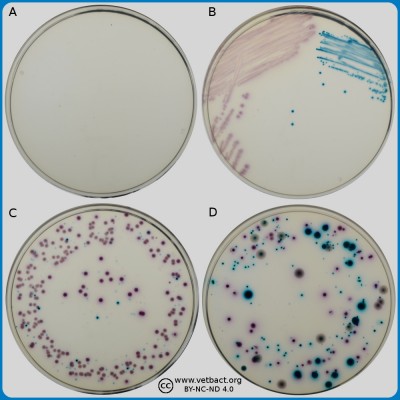Chrome agarThe figure shows Chrome agar plates with cefotaxime, where bacteria have not been cultivated on plate A. Escherichia coli (to the left) and Enterococcus spp. (to the right) have been cultivated on plate B. Faeces samples with a mixed culture of E. coli and Enterococcus spp. from a calf have been cultivated on plates C and D . Note the coulur differences, E. coli colonies have a pink colour and Enterococcus spp. are turquoise blue. Since cefotaxime has been added to these Chrome agar plates, the growth on these plates indicate that the bacteria are resistant to carbapenem (ESBL producing). The Images is photographed with lighting from below - Click on the image to enlarge it. Image: Ingrid Hansson (SLU), Lise-Lotte Fernström (SLU) & Karl-Erik Johansson (SLU). Applications:Chromogenic media facilitate the isolation and differentation of bacteria as specific bacteria grow with different distinct colony appearance. There are different variants of chromogenic agar, which can be used for cultivation and sometimes also for differentitation of bacteria, for instance:
Content of the medium:
The final pH of this medium used to be 7.0. Other comments:Colonies of different bacteria will appear in different colours, bellow are some examples.
Updated: 2019-10-24. |

